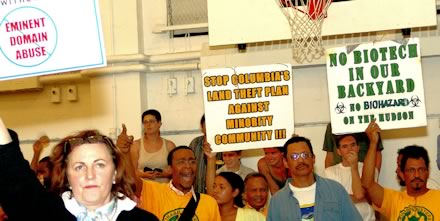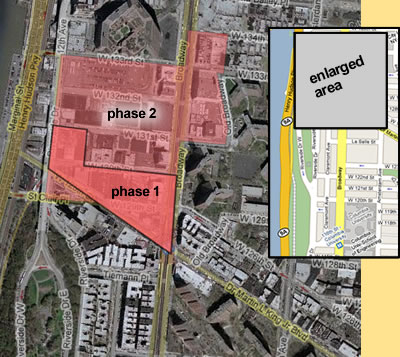Posted November 23, 2007
On Nov. 10th several hundred community members met at historic St. Mary’s Church in Harlem and marched through the public housing complex chanting “Harlem: Not For Sale!” and “Public Housing: Not For Sale!” to Columbia University’s main campus. There, students joined them to protest what some are calling “Hurricane Columbia”, a reference to the struggles against gentrification and population removal in New Orleans. For over four and a half years, a grassroots Coalition to Preserve Community has been leading the charge against the university’s proposed bulldozing and development of 18 acres in Harlem for a new bio-technology / bio-medical research campus. This is a fight about profit, racism, local politicians and community power!

University, Inc.
Why would Columbia, with an endowment of nearly $6 billion, need to use eminent domain to evict thousands of low-income, Black and Latino residents when it can afford any property they don’t already own? Like other businesses, it wants to expand and bring in more money. In 2005, Columbia received over $718 million in grants, 74% of which was for bio-medical research. Where does this money come from? Well, we’re paying for it: 82% of it is from our taxes. But we aren’t even getting what we pay for: in 2005 about $40 million of the amount granted was never spent. If that’s not enough to make you boil, Columbia also makes huge profits from selling the results of the research we fund. In all, 70 “spin-off” companies have turned a nice profit of over $1.75 billion. In the last year alone, the university earned over $26 million just from these patents (on what should be public), more than all the tuition from all its students! So, research is where the money is—not the students—and like any big business, that’s what counts. Oh, and because it is officially “not-for-profit” (yeah, right!), all this money is tax exempt! That’s right, communities are paying to be evicted, all for the university’s bottom line.
Gentrification and Racism
Developers try to get what they want the easiest way they can. Gentrification in Harlem, like elsewhere, has always been a racist process of sacrificing communities of color because it’s usually easier than sacrificing rich white peoples’ neighborhoods. Columbia’s attempts to take over the surrounding areas of Harlem go back at least 50 years, and include its infamous 1968 plan to build a private gym in Morningside Park, a public park. The fancy main entrance would have been for students, with a back-door entrance for Harlem residents at the bottom of the hill. These plans were widely viewed as racist, and even (then future) Mayor Dinkins was calling it out.
The current round with Columbia is no different: the university counts on the mostly Black and Latino working class communities around it being powerless against it; that politicians are easily bought; that the community doesn’t have money for fancy lobbyists or friends in high places. Columbia is afraid of being labeled as racist, however, so they are trying to hide it with a special “WE’RE NOT RACIST” campaign. Dinkins himself has now come out in favor of the gentrification plan, writing last May in the New York Times that all the jobs and entrepreneurial opportunities will be great for the community. Even NAACP has come out supporting the university, talking about the “many benefits that the local community will gain from the proposed expansion,” but basically says it will create jobs. The university has created a fake pro-Columbia community group called “Coalition for the Future of Manhattanville” with the help of Bill Lynch, a prominent Democratic Party lobbyist and former deputy mayor under Dinkins. They pulled all the stops in this show at a Community Board 9 meeting in mid-August, making sure that these people were there, and, responding to the crowd’s chants about the racist plans, the NAACP even explicitly said that Columbia is officially NOT RACIST.

The area of Harlem affected by Columbia’s expansion.
Sell-Out Politicians
This struggle has demonstrated that the Democratic Party politicians of the area are racing to sell out their constituents! City Council member Robert Jackson (District 7) comes around with the standard “I support the community” talk, but in September Jackson’s chief of staff took up the fight on behalf of the university and its fake community group, trying to undermine any opposition to the university’s illegal land-grab. At public hearings, he’s always the first to tell the community, “sit down, and stop bothering these fancy people in the suits.” But does he ever take a stand with the residents? No. Does he march with them in the streets? No.
Manhattan’s Borough President Scott Stringer is another one trying to play residents for fools. He’s spent the last few years running around talking like Robin Hood—calling himself an advocate for “development that reflects neighborhood values”—but all he’s doing in robbing the neighborhood! Over the summer, his “West Harlem Special District” tried to make Columbia’s takeover easier to swallow, but it doesn’t deal with the main issue: Columbia wants the neighborhood for itself! Sure enough, by the end of September, Stringer announces that he has come to an agreement with the university. Where are the residents in this process? He reluctantly put up with the public review process, only conclude that despite all the community’s opposition, his job was to start making deals. And is he in the streets? No.
Students Support the Community
There have always been students involved in this fight against population removal—as in 1968, they’ve been in the streets with the community! Students are also organizing against racism in the classroom, demanding an end to the Eurocentric old-white-men curriculum and strong ethnic studies department. They also want their university to stop bullying and trying to remove a whole community. Frustrated with the channels recommended by the fancy people in suits, these students were on a hunger strike for these demands for 10 days, but the university is holding onto its gentrification plans with all it has. Nonetheless, the students did get many of their curriculum demands through their struggle.
A Right to the City!
In 1968 the community rallied against a powerful developer and won! Community members laid down in front of bulldozers, the students took over the campus and the big money guys in the fancy suits were beaten back! 1968 was about a public park. Now they want a whole neighborhood. Columbia is far from the only one gentrifying these neighborhoods out of existence (i.e. Pinnacle Group or HPD), but it is one of the biggest right now. No one knows exactly how far its effects will reach, but it’s a storm looming over all of us. Residents have a right to their city, and they are fighting for it!

Comments
2 responses to “Fighting Against the Storm”
Columbia is one of the world’s great academic institutions. To argue that they are racist and that they are “out for profit” is very small-minded. The fact is, New York City is falling behind in terms of its competitiveness with other cities that are armed with a barrage of leading institutions (Boston and Silicon Valley, namely). Columbia faces a hard choice: expand, or run the risk of falling behind its Ivy-league fellow institutions. The strong opposition of this expansion is a telling sign of the American way of de-valuing education and all it has to offer, both to its students, and to the surrounding areas. Columbia will, and always has, attracted bright minds that continue to enhance NYC’s intellectual diversity; why would you want to limit this?
The description of many local politicians’ spinelessness here is on point. Last year there was a campaign to stop free City tax giveaways to luxury developers, many of which are being built in upper Manhattan. Of course the councilmembers for Washington Heights and Inwood — including the one named in this piece– opposed this campaign. It’s exciting to hear that many grassroots groups are setting their eyes on the next council election cycle with the goal of striking some fear into these guys’ hearts, especially on the heels of the anti-Columbia campaign.